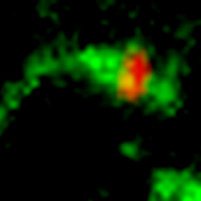Stopping Shiga Toxin

E. coli bacteria

Shiga toxin (green), epidermal growth factor (red)
The deadly bacteria known as Shiga toxin has killed more than 1 million people worldwide. And there is no treatment.
But now there's hope.
Carnegie Mellon University researchers have discovered that an element commonly found in nature might provide a way to neutralize its lethal effects.
New results published in the Jan. 20 issue of Science by CMU biologists Adam Linstedt and Somshuvra Mukhopadhyay show that manganese completely protects against Shiga toxicosis in animal models.
Produced by certain bacteria, including Shigella and some strains of E. coli, Shiga toxin can cause symptoms ranging from mild intestinal disease to kidney failure.
The findings could pave the way for future research aimed at creating an inexpensive treatment for infections caused by bacteria that produce the lethal Shiga toxin.
Currently there is no treatment for such infections that afflict more than 150 million people each year.
Such infections are common in developing countries where they cause waterborne epidemics. The infections can be particularly deadly, especially in children, causing dysentery and severe hemorrhagic diarrhea, which cannot be adequately treated in areas without access to clean water.
In developed countries, Shiga toxicosis is most common during foodborne outbreaks — like the widespread E. coli outbreak this past summer in Germany and Western Europe, where more than 3,700 people were infected and 45 died.
After entering the body, Shiga toxin is secreted by the infecting bacteria. The toxin then attaches itself to a surface receptor on a cell's plasma membrane and enters the cell through a process called endocytosis.
Normally, when a harmful substance enters a cell in this way, it's wrapped in a package called an endosome and sent directly to the cell's lysosome where it is degraded and discarded.
"That's exactly the process that Shiga toxin avoids. It would be neutralized if it were to get degraded, so it had to find some way to get out of being sent to the lysosome," said Linstedt, professor of biological sciences at CMU.
Linstedt and Mukhopadhyay discovered exactly how Shiga toxin avoided the lysosome as they were doing basic biological research to understand how components of the cell function.
"If we weren't focused on answering fundamental biological questions, we wouldn't have made this discovery," Linstedt said.
The research, an example of how Carnegie Mellon uses government and foundation funding to develop real-world solutions, was funded by a grant from the National Institute of Environmental Health Sciences, part of the National Institutes of Health and an American Heart Association fellowship to Mukhopadhyay.
Related Links: Read the press release | Dept of Biological Sciences | Mellon College of Science
